
Communication Law
Practical Applications in the Digital Age
- 492 pages
- English
- ePUB (mobile friendly)
- Available on iOS & Android
Communication Law
Practical Applications in the Digital Age
About this book
This fully revised third edition brings a fresh approach to the fundamentals of mass media and communication law in a presentation that undergraduate students find engaging and accessible.
Designed for students of communication that are new to law, this volume presents key principles and emphasizes the impact of timely, landmark cases on today's media world, providing an applied learning experience. This new edition offers expanded coverage of digital media law and social media, a wealth of new case studies, expanded discussions of current political, social, and cultural issues, and new features focused on ethical considerations and on international comparative law.
Communication Law serves as a core textbook for undergraduate courses in communication and mass media law.
This edition includes timelines to show students "what happened when" in the legal process. These simple diagrams are available at www.routledge.com/9780367546694.
Frequently asked questions
- Essential is ideal for learners and professionals who enjoy exploring a wide range of subjects. Access the Essential Library with 800,000+ trusted titles and best-sellers across business, personal growth, and the humanities. Includes unlimited reading time and Standard Read Aloud voice.
- Complete: Perfect for advanced learners and researchers needing full, unrestricted access. Unlock 1.4M+ books across hundreds of subjects, including academic and specialized titles. The Complete Plan also includes advanced features like Premium Read Aloud and Research Assistant.
Please note we cannot support devices running on iOS 13 and Android 7 or earlier. Learn more about using the app.
Information
1
Sources of Law and Systems of Justice
- how the branches of government limit each other’s legal authority in crafting laws
- what judicial review can do to uphold acts of law or strike them down
- where courts proceed when neither legislative acts nor legal precedents apply
- how cases are assigned to courts by regional or subject jurisdiction
- the manner by which regulatory agencies administer regulations
- how historical precedents contrast with other forms of precedent
- the contrasting legal processes of civil and criminal law
Public Protests and the Rule of Law
Sources of Law

Table of contents
- Cover Page
- Half Title Page
- Title Page
- Copyright Page
- Contents Page
- Acknowledgments Page
- About the Authors Page
- 1 Sources of Law and Systems of Justice
- 2 First Amendment in Principle and Practice
- 3 Sedition and Censorship
- 4 Forums of Freedom
- 5 Libel
- 6 Privacy
- 7 Intellectual Property
- 8 Broadcasting and Telecommunications
- 9 Digital Online Media
- 10 Obscenity and Indecency
- 11 Advertising Law
- 12 Media Business Law
- 13 Media and Courts
- 14 Freedom of Access
- Case Index
- Subject Index